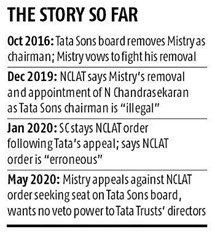In his affidavit filed in the Supreme Court, Mistry gave details on businesses which, he claimed, had failed due to wrong business calls made by Mistry’s predecessor, Ratan Tata.
Cyrus Mistry, former chairman of Tata Group, has said his stand on the group’s sick businesses was vindicated as losses in these “legacy hotspots” continued to mount even after a new management, led by the current chairman N Chandrasekaran, took over.
Article by Dev Chatterjee | Business Standard
In an affidavit filed in the Supreme Court (SC), Mistry gave details of every business that, he claimed, had failed because of wrong business calls made by his predecessor, Ratan Tata.
Both Tata and Mistry have moved SC against the National Company Law Appellate Tribunal’s (NCLAT’s) December order that reinstated Mistry as a director on Tata Sons board and deemed his removal as “illegal”. The SC, however, stayed the NCLAT order on January 11. The SC said the tribunal also granted the prayers which were not prayed for by Mistry.
The petitions will be heard by the SC from next month.
In May, Mistry had challenged the NCLAT’s order as it reinstated him only till his tenure that was to end after a few months. The Mistry family, which owns 18.5 per cent in Tata Sons — the principal investment holding company and promoter of Tata companies, wants a permanent seat on Tata Sons board.
Mistry said Tata’s telecom sector investments continued to make huge losses, and the current management, for reasons best known to them, decided to sell the existing assets of Tata Teleservices, including the extremely valuable and liberalised spectrum licences, access to an extensive fibre network, and 40 million customers for free to Bharti Airtel.
“Worse still, whilst all of this was sold for effectively no consideration, the management of Tata Sons chose not to sell the enterprise and retail business to another potential suitor who was offering in excess of $1 billion,” Mistry said in his affidavit.
Recently, the additional liabilities to the tune of Rs 14,000 crores towards AGR (adjusted gross revenues) dues have surfaced in Tata Teleservices. Thus, the value destruction to Tata Sons will be close to Rs 60,000 crore, which is in excess the anticipated figure of $6 billion (approximately Rs 42,000 crore), he said.
ALSO READ: Tata trustees’ conduct violated rules of insider trading, says Cyrus Mistry
Mistry said soon after he was removed, he had raised concerns relating to the risk of considerable future impairments with respect to the Mundra power project, which Tata Power aggressively bid for during Ratan Tata’s tenure. “The capital employed at Mundra project was approximately Rs 18,000 crore. This venture has lost money for several years and continues to do so. In fact, for 2017-18, Tata Power was constrained to make a provisioning for an impairment of Rs 3,555 crore in its books, which was attributable to the Mundra project. In FY19, the losses suffered on account of the Mundra project were approximately Rs 1,654 crore, which, in turn, brought down the overall profitability of Tata Power,” he said.
The losses sustained would have been even higher, had Tata Power, as the parent company, not transferred some of the interest expenses on to its books. “Recently, Tata Power MD stated that even after the tariff revision, the company would continue to lose money,” Mistry said.
On Tata Motors, Mistry said he had raised the issue of historically aggressive accounting policies for the capitalisation of product development costs that would create a future liability. The company has since changed the policies and had to take a significant loss, particularly in Jaguar Land Rover. Several emails from the management of Tata Motors reveal that the Nano project, another hotspot, had lost money since its inception, and in some years, the vehicles were sold below the direct cost of materials. The losses peaked at Rs 1,000 crore a year and till first quarter of FY17, the cumulative losses were nearly Rs 6,000 crore.
“Though the board of Tata Motors decided to shut the plant in October 2016, till today the it has not been shut for emotional reasons, despite it not producing even a single car,” Mistry said.
He also raised grave concerns relating to the European steel business and the potential impairments facing the Tata Steel group, only a part of which was recognised, on account of the Corus Steel acquisition during Tata’s tenure in 2007 for $12 billion.
“Despite additional investments over the years, the cumulative losses to date have been $1.5 billion. After I was removed, a further £1-billion investment into Port Talbot in the UK was committed. Subsequently, the UK operations in 2019 were declared one of their largest losses yet at £381 million for the year.”


